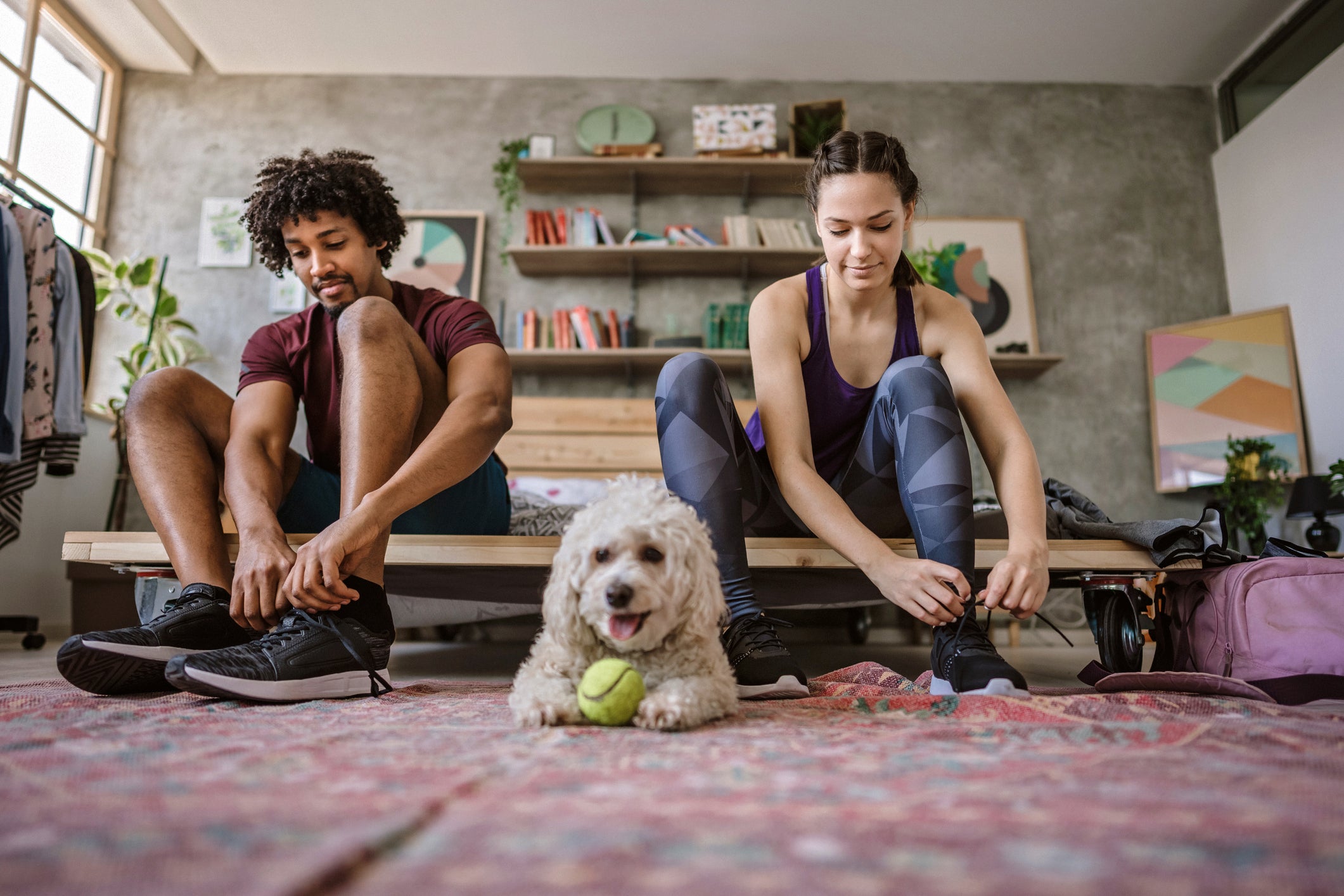It’s Normal To Feel Sore In The Morning

Young multi-ethnic couple sitting on bed at apartment and preparing for jogging, fluffy dog sitting near them
If my memory was wiped clean and I experienced my body for the first time at 5 AM during heavy training, I’d assume that I spend my free time as a good stuntman or bad bull rider. I feel fine lying down (usually). But that first step out of bed feels like a practical joke.
My ankles are hilariously sore. In fact, you can call my entire lower legs “US democracy” because of how much they lack structural integrity. At the very least, something definitely got gerrymandered between my feet and my calves.
That general soreness from the knee-down is a given for me. Sometimes, my body adds back stiffness and hip aches. And it has been like this for as long as I remember, at all training volumes other than zero. When my 9-year old dog Addie wakes up and immediately bounds down the stairs, I briefly contemplate taking her joint pills. (USADA announcement: Boulder-based running coach tests positive for being the goodest dog).
RELATED: Sore Muscles? It Might Be Your Diet
Give it some time, and I feel better.
The walk down the stairs for coffee is usually one halting step at a time. The walk to the bathroom a few minutes later is a bit more normal. The second and third walks to the bathroom (prunes) are downright springy. But I learned long ago that I shouldn’t judge how I feel first thing in the morning.
Call it the Reverse Black Knight. My appendages get reattached to my body one-by-one, overcoming whatever apparent flesh wounds I received overnight.
I used to feel pretty self-conscious about it. “I bet the really good runners don’t feel like that,” I thought. “Maybe I’m not cut out for this. Maybe this sport is unhealthy for me. Maybe I just suck.”
But then I asked around over years of coaching and learned….yeah, that’s just how the body feels for some people during long-term training (but not all, with seemingly random variation). Anecdotally, faster-twitch athletes seem to get a bit more AM soreness from endurance training, but that hypothesis could be finding a signal in the noise. A lot of the athletes I talked to had similar self-conscious thoughts, though, thinking it was something weird about their physiology. I even had 25-year old athletes tell me that they were just getting old. We should have a card for our wallets with some AARP discounts (American Association of Running People).
RELATED: 7 Rules For Recovering After A Hard Run
It’s totally normal to be sore and stiff.
This article is a validation of some AM soreness as a proxy for strong training, rather than overall breakdown, written for athletes that feel like their joints are having an existential crisis at 5 AM. Scientists aren’t exactly sure why people may feel like they got intimate with a sledgehammer in their sleep. Perhaps it’s due to overnight inactivity, leading to fleeting tightness. It could be related to circadian variation in inflammatory markers. Maybe it’s even tied to adaptation processes in muscles and joints, with variation based on individually variable physiology and training background. No one is exactly sure (though there are some cool studies that may provide possible explanations by looking at the heightened overnight discomfort experienced by some people with autoimmune conditions like rheumatoid arthritis).
I just want to let you know that if you share that AM soreness, you’re not alone, and it’s probably not a sign that you need to back off training. Yes, too much running can cause injuries and persistent soreness during the day, which are not great for growth. But other articles on this topic sometimes cite “lack of exercise” as a reason for soreness as well.
I’d be curious to see a study that examined whether there was any significant variation in AM soreness for athletes based on training volume, or if soreness variation led to different race outcomes. I bet that in some people, increased AM soreness may correlate with better health outcomes in general, indicative of a more active life.
RELATED: Strength Train To Avoid Injury
If the soreness passes after you start moving around, you are good.
You don’t need to be like I was, worried that an activity you love is breaking you down cell by cell, as if your body is an aging castle in France.
Make sure you’re treating your body well and doing what you need to do for adaptation. Take your rest days. Don’t elevate training mileage as a 1:1 proxy for growth. Don’t run through pain that increases as you go. Practice self-massage techniques (I am a big fan of a percussive massage tools like Theragun or Hypervolt). Consider stretching if you are inflexible (or not stretching if you are naturally loose). Eat plenty, and make sure you get enough protein (and fat and carbs). Try to sleep 8 hours, but don’t stress about it.
Most of all, don’t judge as long as your energy levels and mood are relatively stable during the day and your performance isn’t suffering during training. Heck, I think that the AM soreness might be one of the coolest parts of an athletic life.
Think about it. Running is a time machine where you can feel 100 years old when you wake up, before traveling back to age 10 on the trails, light and free. If the choice is between stable, predictable feelings and a big, uncertain range, I’ll jump up to take that range any day of the week.
Just give me 5 minutes to loosen up first.
RELATED: Nail Your Post-Race Recovery
David Roche partners with runners of all abilities through his coaching service, Some Work, All Play. With Megan Roche, M.D., he hosts the Some Work, All Play podcast on running (and other things), and they wrote a book called The Happy Runner.